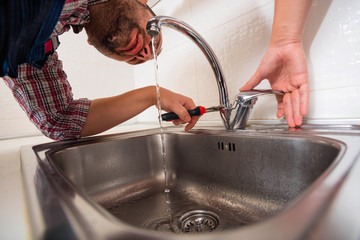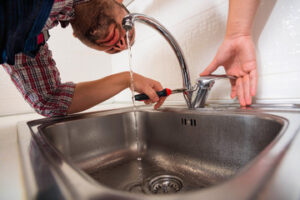Bathtub installation can feel like a major project, especially when remodeling a full bathroom. Follow this guide to make the job easier and avoid costly mistakes. If your old tub surround is glued to drywall, pull it off with a pry bar and hammer. Add new 2×4 nailers to the studs to support a ledger board where necessary. Visit Website to learn more.

If you’re installing a new tub, it’s important to do things correctly. The tub needs to be properly supported so it doesn’t flex when you stand on it, and the plumbing must be connected to it correctly so water doesn’t leak or back up through the wall. If you’re uncomfortable with doing this kind of work, it’s best to hire a professional plumber.
Before you start working on your bathtub installation, make sure the water is turned off and that the old drain plumbing is disconnected. Also, turn off your home’s main water supply line in case there are any problems with the pipes during the process.
Next, lay down a piece of cardboard or plywood over the floor where you’re working to protect it from damage. You’ll need to remove any nails or screws that are anchoring the tub flange to the studs in order to remove and install the new one. It’s also a good idea to cover the surrounding walls with a plastic sheet to prevent any splashes of mortar.
Use a pry bar or screwdriver to loosen and remove any screws or nails holding the flange of the tub in place. After the flange is removed, use a pair of pliers to loosen the drain stopper and linkage. Then, disconnect the trip lever and rocker assembly by turning them counterclockwise to open it. You may need a wrench to do this, depending on the type of drain you have.
Once all the parts are removed, carefully slide the new tub into the alcove. Ensure the bottom lip of the tub is resting on your bed of mortar, and use a level to check that it is straight. If it’s not, you can correct the problem by mixing more mortar and re-laying the lip.
Now, if the manufacturer has given you specific instructions about where to set your tub, use your level to determine that the flange is in the center of the studs. If not, you can adjust the studs by drilling or tapping them in place to make sure they are straight. Now, you can connect the waste and overflow pipe to the drain outlet using plumber’s putty and Teflon tape, which you can tighten with a wrench.
Ledger Board
The ledger board is a critical part of the bathtub installation process because it reduces the amount of weight and stress that is put on the deck framing and tub flange. It also prevents moisture from leaking into the house. If you are installing a new deck, the ledger board should be installed before you dig your footings and set posts. It should also be used as the basic point of reference for determining all the joist framing.
Look at your house and determine if it is sided with traditional lumber frame under clapboard or beveled wood siding. If it is, a small section of the siding will need to be removed so you can attach the ledger board. Once the ledger is in place, it is secured to the house wall using joist hanger brackets and treated deck screws. The joist hanger brackets are pre-bent to fit the inside corner of the ledger and building wall. They are also affixed to the ledger with special 1-1/2″ long double hot-dipped zinc coated joist hanger nails.
Find the height that you want your tub to sit at and mark it on the ledger board. Then mark a line 5.5″ above that on the siding under the ledger. Fold a piece of ledger tape into that spot, remove the release liner and press to adhere.
Screw the ledger board into the joists, being careful not to screw into the flange of the bathtub. Screws should be spaced about 4′ apart or so. Some builders used to use nails for this job, but lag screws are more durable and will hold stronger because of their metal construction.
When you’re done, use Kerdi-Fix to seal the holes that were created. This is important because you want the walls to be as flat as possible for a strong and professional finish.
Check the manufacturer’s specifications for your tub to see if there are specific distances you need to account for on the ledge where the stringer board is mounted. Find the studs in the wall where you marked the ledger and mount a 2×4 to that location. This will be the stringer board that supports the tub. Screw this into the joists with structural lag screws (also called “heavy duty” screws).
Faucets
Before you can set the bathtub in its alcove, you’ll need to install the faucets. You can’t do this until you’ve disconnected the water supply lines (Photo 1). Locate the shutoff valves, usually in an accessible panel in another room or the basement. Turn them off to cut off the water, then take apart your existing shower head, tub spout and handle (Photo 2). Put the parts in a bag or box for safekeeping.
Use a screwdriver to unscrew the faucet hardware from the back of the wall. Identify the type of drain assembly, and get a replacement that matches it. If you’re replacing an old bathtub, you can reuse the spout and drain cover but you’ll need to find or purchase new tub filler and drain shoe.
Once you’ve removed the old faucet assembly, make a mark on each wall stud across the top of the tub flange. This will indicate where to locate the new stringer board. Cut a two-by-four to match the length of the new flange and line it up with the marks on the studs. Screw the board to the studs with exterior grade screws.
Before you place the new tub in its alcove, look down the front of the tub to see if there’s a 1″ gap between the bottom of the tub and your floor below. This will ensure that the tub sits on a solid surface and that the overflow tube and drain shoe fit well.
If you’re using a standard chrome-plated or nickel-plated finish, paint the overflow tube and shoe with enamel paint to match your tub. Otherwise, you can buy matching paint from the tub manufacturer.
If you’re installing a ceramic-disk cartridge faucet, you don’t need to paint it. These high-tech faucets are extremely durable and easy to repair. However, they’re expensive compared to other types of tub faucets, and you might have trouble finding an experienced plumber to repair one if it breaks down. For this reason, many builders recommend that homeowners stick with name-brand products from wholesalers they can trust to stand behind their products.
Drains
A tub needs a drain and, in most cases, a waste-and-overflow (WO) pipe. Using the tub manufacturer’s directions, drill holes for these accessories. Some bathtubs include an insulated support structure on the bottom; in this case, you don’t need to install additional pipes. Otherwise, mix a batch of mortar and spread a thick layer where the main tub drain will be. Be sure to leave several inches clear of the primary drain location. Some manufacturers advise that you drill through the acrylic tub flange and drive screws to the studs, while others recommend hammering nails into the ledger board (which is also called a “stringer”).
If your new tub has an overflow tube and shoe, install these as well. It’s a good idea to lay out a diagram before you start work, since every bathtub is a little different and each has its own specific installation requirements.
Test the water flow and connections by filling the tub and turning on the hot and cold faucets. If everything is fine, you’re ready to move on to the next step.
Before installing the tub, note how the apron — or outer edge — meets the finish floor. If there’s a gap, you can fill it with a silicone sealant.
It’s a good idea to build in an access panel that’s large enough for you or someone working for you to reach the old drain and tub fittings. You’ll need access later to repair or replace these, and you don’t want to be left without a way to get to them in the middle of a project.
Once the ledger board is crewed, it’s a good time to add the drywall to the ceiling around the tub. If you’re not going to tile the walls, it’s especially important that you put a moisture barrier on the drywall and use water-resistant caulking to seal all joints. In some cases, you’ll need to add a sheet of plywood or cement backerboard as an additional water barrier beneath the bathtub.


